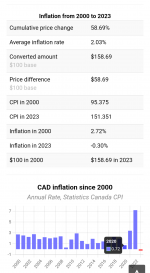The Canadian dollar has lost 37% its value since 2000
Updated: May 10, 2023
$100 in 2000 is equivalent in purchasing power to about $158.69 today, an increase of $58.69 over 23 years. The dollar had an average inflation rate of 2.03% per year between 2000 and today, producing a cumulative price increase of 58.69%.
This means that today's prices are 1.59 times as high as average prices since 2000, according to Statistics Canada consumer price index. A dollar today only buys 63.016% of what it could buy back then.
The inflation rate in 2000 was 2.72%. The current inflation rate compared to last year is now -0.30%. If this number holds, $100 today will be equivalent in buying power to $9

Buying power of $100 in 2000
This chart shows a calculation of buying power equivalence for $100 in 2000 (price index tracking began in 1914).
For example, if you started with $100, you would need to end with $158.69 in order to "adjust" for inflation (sometimes refered to as "beating inflation").
When $100 is equivalent to $158.69 over time, that means that the "real value" of a single Canadian dollar decreases over time. In other words, a dollar will pay for fewer items at the store.
This effect explains how inflation erodes the value of a dollar over time. By calculating the value in 2000 dollars, the chart below shows how $100 is worth less over 23 years.
According to Statistics Canada, each of these CAD amounts below is equal in terms of what it could buy at the time:

Updated: May 10, 2023
$100 in 2000 is equivalent in purchasing power to about $158.69 today, an increase of $58.69 over 23 years. The dollar had an average inflation rate of 2.03% per year between 2000 and today, producing a cumulative price increase of 58.69%.
This means that today's prices are 1.59 times as high as average prices since 2000, according to Statistics Canada consumer price index. A dollar today only buys 63.016% of what it could buy back then.
The inflation rate in 2000 was 2.72%. The current inflation rate compared to last year is now -0.30%. If this number holds, $100 today will be equivalent in buying power to $9

Buying power of $100 in 2000
This chart shows a calculation of buying power equivalence for $100 in 2000 (price index tracking began in 1914).
For example, if you started with $100, you would need to end with $158.69 in order to "adjust" for inflation (sometimes refered to as "beating inflation").
When $100 is equivalent to $158.69 over time, that means that the "real value" of a single Canadian dollar decreases over time. In other words, a dollar will pay for fewer items at the store.
This effect explains how inflation erodes the value of a dollar over time. By calculating the value in 2000 dollars, the chart below shows how $100 is worth less over 23 years.
According to Statistics Canada, each of these CAD amounts below is equal in terms of what it could buy at the time:
